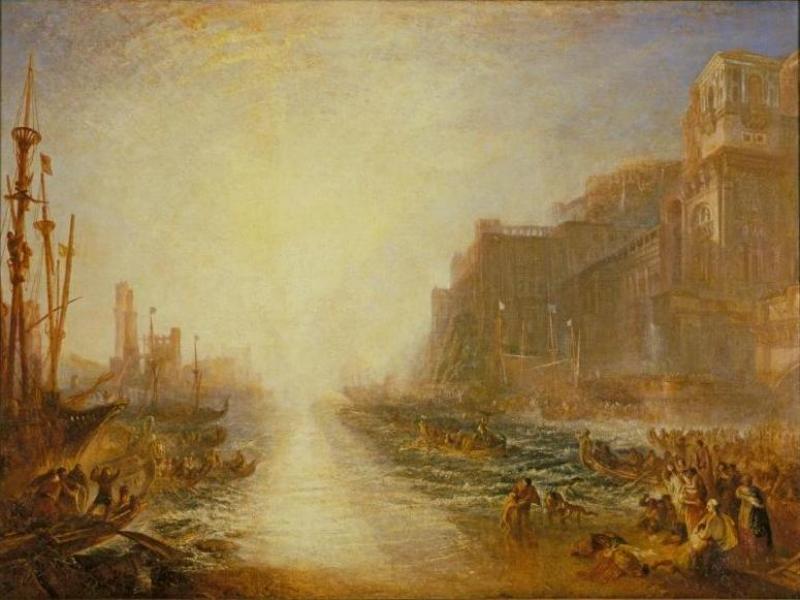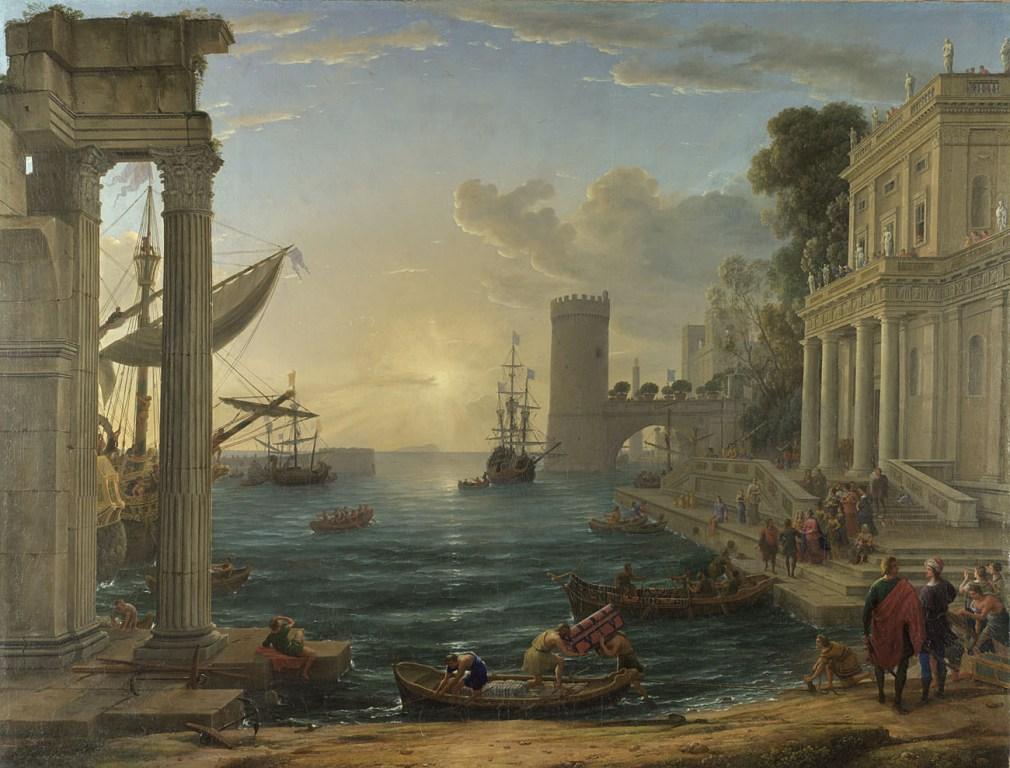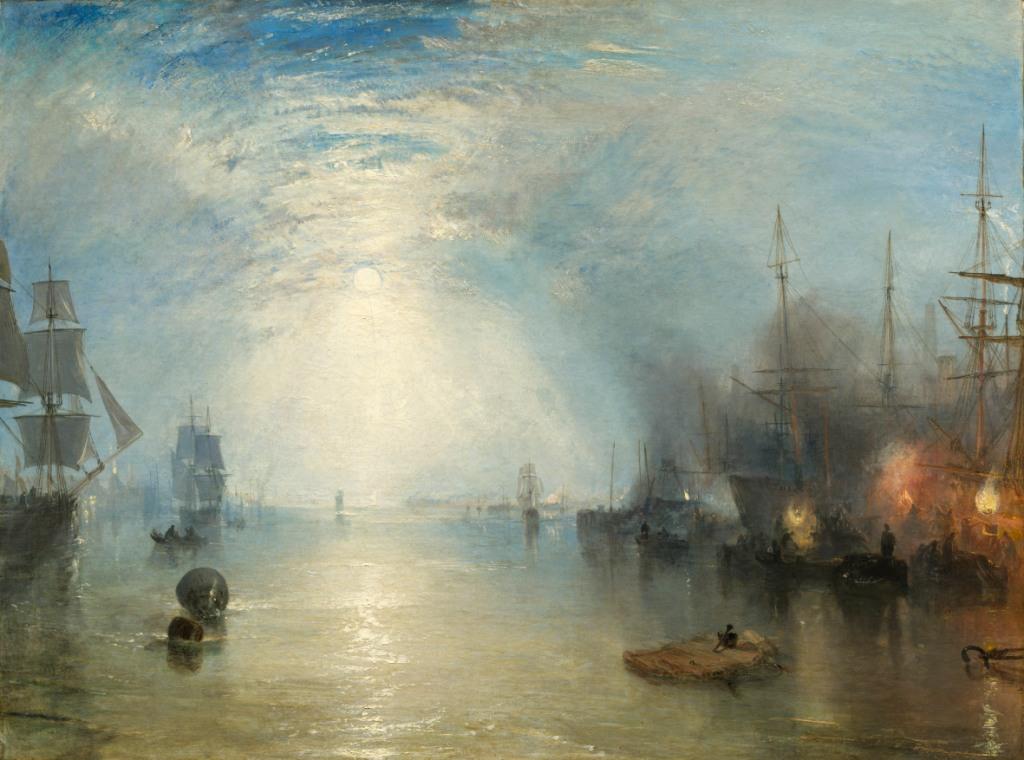Turner Inspired: In the Light of Claude, National Gallery | reviews, news & interviews
Turner Inspired: In the Light of Claude, National Gallery
Turner Inspired: In the Light of Claude, National Gallery
Fascinating visual essay illuminates Claude Lorrain's influence on JMW

The British grand tourists not only fell in love with Italy. They fell in love with the landscapes of 17th-century ex-pat artist Claude Lorrain (1604/5-1682), depicting the Roman campagna in which the gods disported themselves. JMW Turner (1775-1851) also fell for the Frenchman, whose work he had seen in significant stately homes while visiting his patrons.
Turner was marvellously ambitious. Rather like Picasso (who notoriously declared "I don’t borrow, I steal"), whenever he saw a quality in other artists which appealed he took it and used it to his great advantage. He was also willing to record his respect and admiration, however, and he admired none of his predecessors more than Claude. He was already in love with light, the pencil of nature. He took from Claude the vastness of landscape, its beauty and importance, but perhaps above all, as the exhibition title suggests, the overwhelming inspiration was a Claudian illumination, the irradiating light from the sun beaming down on an idealised landscape from the centre of a limitless sky. On his deathbed Turner's (possibly apocryphal) last words were "the Sun is God".
Compared to Claude, Turner seems almost rowdy, even rambunctious
In part, this is a visual essay on changing styles and attitudes. Compared to Claude, Turner seems almost rowdy, even rambunctious. Although he was a dazzling success with cardinals, princes, several popes and kings - even his affluent patrons suggested his prices were high - Claude's landscapes look curiously static, calm and ordered. Even so, his cult has continued, and even now is echoed in many a public park, as well as gardens such as Blenheim and Stowe.
 His paintings are almost like collages from various motifs of ruins and trees, vistas and valleys. The Enchanted Castle is a fantasy wrapped around the story of Cupid and Psyche, while in Seaport with the Embarkation of the Queen of Sheba (pictured above) the sheer bravura of the low-lying sun makes the water glitter and gleam seemingly in a straight path of light towards the shore. In his will, Turner stipulated that this was one of the two Claudes his own paintings should hang beside in the National Gallery; here it is close to Turner’s own Sun Rising through Vapour, a more mundane subject showing fishermen cleaning their catch on the seashore.
His paintings are almost like collages from various motifs of ruins and trees, vistas and valleys. The Enchanted Castle is a fantasy wrapped around the story of Cupid and Psyche, while in Seaport with the Embarkation of the Queen of Sheba (pictured above) the sheer bravura of the low-lying sun makes the water glitter and gleam seemingly in a straight path of light towards the shore. In his will, Turner stipulated that this was one of the two Claudes his own paintings should hang beside in the National Gallery; here it is close to Turner’s own Sun Rising through Vapour, a more mundane subject showing fishermen cleaning their catch on the seashore.
It is, however, Turner's sheer passion for light that dominates this show by virtue of a trio of masterpieces: Regulus - a fantasy of a Roman seaport, indebted to Claude - flanks Keelmen Heaving in Coals by Night (pictured below), a genuine and terrific engagement with contemporary life. The shadowy shapes of the labourers are illuminated by fiery torches. As they unload the high-masted ships berthed to the side, the full moon pours light upon the sea. It is an extraordinary evocation of the arduous nature of the Industrial Revolution, transmogrified into a scene of irresistible beauty.
 Exquisitely sombre, softly insinuating light also illuminates East Cowes Castle, the Seat of J Nash, Esq; the Regattas starting for their Moorings. Turner's still-astonishing ability – so vastly different from Claude's – to transform the observable world is perhaps summed up in two watercolour sketches. An Industrial Town, probably Birmingham, Colour Study is just that, the smoking factory chimneys punctuating a scene which varies from golden red to bluish-white swathes of light. In Sunrise 1825-1830 the central white disc is suspended in the softest variations of yellow-white possible, with just a whisper of a suggestion for horizon and shore. Claude has vanished; and Turner remains.
Exquisitely sombre, softly insinuating light also illuminates East Cowes Castle, the Seat of J Nash, Esq; the Regattas starting for their Moorings. Turner's still-astonishing ability – so vastly different from Claude's – to transform the observable world is perhaps summed up in two watercolour sketches. An Industrial Town, probably Birmingham, Colour Study is just that, the smoking factory chimneys punctuating a scene which varies from golden red to bluish-white swathes of light. In Sunrise 1825-1830 the central white disc is suspended in the softest variations of yellow-white possible, with just a whisper of a suggestion for horizon and shore. Claude has vanished; and Turner remains.
Buy
Explore topics
Share this article
The future of Arts Journalism
You can stop theartsdesk.com closing!
We urgently need financing to survive. Our fundraising drive has thus far raised £49,000 but we need to reach £100,000 or we will be forced to close. Please contribute here: https://gofund.me/c3f6033d
And if you can forward this information to anyone who might assist, we’d be grateful.

Subscribe to theartsdesk.com
Thank you for continuing to read our work on theartsdesk.com. For unlimited access to every article in its entirety, including our archive of more than 15,000 pieces, we're asking for £5 per month or £40 per year. We feel it's a very good deal, and hope you do too.
To take a subscription now simply click here.
And if you're looking for that extra gift for a friend or family member, why not treat them to a theartsdesk.com gift subscription?
more Visual arts
 'We are bowled over!' Thank you for your messages of love and support
Much-appreciated words of commendation from readers and the cultural community
'We are bowled over!' Thank you for your messages of love and support
Much-appreciated words of commendation from readers and the cultural community
 Folkestone Triennial 2025 - landscape, seascape, art lovers' escape
Locally rooted festival brings home many but not all global concerns
Folkestone Triennial 2025 - landscape, seascape, art lovers' escape
Locally rooted festival brings home many but not all global concerns
 Sir Brian Clarke (1953-2025) - a personal tribute
Remembering an artist with a gift for the transcendent
Sir Brian Clarke (1953-2025) - a personal tribute
Remembering an artist with a gift for the transcendent
 Emily Kam Kngwarray, Tate Modern review - glimpses of another world
Pictures that are an affirmation of belonging
Emily Kam Kngwarray, Tate Modern review - glimpses of another world
Pictures that are an affirmation of belonging
 Kiefer / Van Gogh, Royal Academy review - a pairing of opposites
Small scale intensity meets large scale melodrama
Kiefer / Van Gogh, Royal Academy review - a pairing of opposites
Small scale intensity meets large scale melodrama
 Jenny Saville: The Anatomy of Painting, National Portrait Gallery review - a protégé losing her way
A brilliant painter in search of a worthwhile subject
Jenny Saville: The Anatomy of Painting, National Portrait Gallery review - a protégé losing her way
A brilliant painter in search of a worthwhile subject
 Abstract Erotic, Courtauld Gallery review - sculpture that is sensuous, funny and subversive
Testing the boundaries of good taste, and winning
Abstract Erotic, Courtauld Gallery review - sculpture that is sensuous, funny and subversive
Testing the boundaries of good taste, and winning
 Edward Burra, Tate Britain review - watercolour made mainstream
Social satire with a nasty bite
Edward Burra, Tate Britain review - watercolour made mainstream
Social satire with a nasty bite
 Ithell Colquhoun, Tate Britain review - revelations of a weird and wonderful world
Emanations from the unconscious
Ithell Colquhoun, Tate Britain review - revelations of a weird and wonderful world
Emanations from the unconscious
 Rachel Jones: Gated Canyons, Dulwich Picture Gallery review - teeth with a real bite
Mouths have never looked so good
Rachel Jones: Gated Canyons, Dulwich Picture Gallery review - teeth with a real bite
Mouths have never looked so good
 Yoshitomo Nara, Hayward Gallery review - sickeningly cute kids
How to make millions out of kitsch
Yoshitomo Nara, Hayward Gallery review - sickeningly cute kids
How to make millions out of kitsch
 Hamad Butt: Apprehensions, Whitechapel Gallery review - cool, calm and potentially lethal
The YBA who didn’t have time to become a household name
Hamad Butt: Apprehensions, Whitechapel Gallery review - cool, calm and potentially lethal
The YBA who didn’t have time to become a household name

Add comment